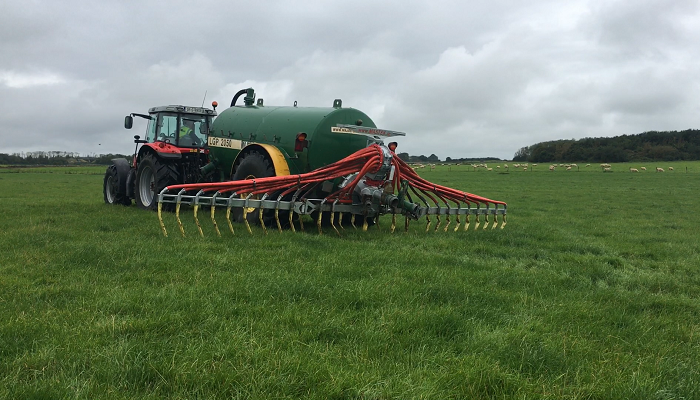02 April 2023
Making sense of nitrogen use

Oisin Coakley, Teagasc Agricultural Catchments Programme Advisor, tells us why the focus right now is on the right place and at the right time.
The use of nitrogen fertiliser is getting lots of attention in recent months. Some of this can be attributed to the massive increase in the cost of chemical fertiliser for the food producer. Environmental impacts from nitrogen are receiving more and more publicity each year. The Agricultural Catchments Programme (ACP) has been studying nitrate (NO₃) in water nearly 15 years in a stream near Timoleague – one of only six sites in the entire country – but water quality is not the only environmental concern.
Nitrogen can also contribute to global warming in the form of nitrous oxide (N₂O). Most of us are aware that carbon dioxide (CO₂) is a greenhouse gas (GHG) and it is by far the most significant – accounting for over three quarters of global warming. There are however other greenhouse gasses, which are given a rating equivalent to the warming potential of carbon dioxide. Nitrous oxide has a global warming potential 265 times greater than CO₂. In Ireland, agriculture contributed to 30% of our national GHG emissions and 90% of nitrous oxide emissions. Nitrous oxide is responsible for one third of the GHG coming from agriculture.
Ammonia (NH₃) is another nitrogen gas released from agriculture. It is not a greenhouse gas, but it can cause human health (breathing) problems and also damages biodiversity and ecosystems. Agriculture is responsible for 99% of all ammonia emissions in Ireland and a significant portion of these losses come from (non-protected) urea fertiliser and slurry spreading in sunny, warm, windy conditions favourable to drying (volatilisation). The greatest way of reducing these losses is through the use of protected urea and low emission slurry spreading.
But getting back to water, the EPA monitor 46 river catchments across the country, comprising of over 2,300 sections of river being assessed. Altogether, just over half of these achieve the desired quality to meet the European Water Framework Directive standards, but in the Bandon – Ilen catchment over 80% of the monitored river sections are considered high or good status. So why all the fuss about nitrate then you might ask?
Nitrogen is more likely to influence the quality of salty water (estuaries and the sea) and the amount of nitrate entering our estuaries along the south coast is higher than the rest of the country and has been increasing a little since 2013. So, while the quality of rivers in West Cork is quiet good, there is concern that estuaries are at risk of deteriorating.
If we want to reduce nitrate losses to water we need to know how and when it gets there. This past summer (2022), we had very little rain and the stream being monitored by the ACP in Timoleague got to a stage of very low flow. As it didn’t rain much for a number of months last summer/autumn, most of the water in the stream came from deep ground water springs, which fell as precipitation in the winter or perhaps years gone by. Old ground water from deep sources are typically lower in nitrate levels and this was reflected in our monitoring station, where the concentration of nitrate during the summer period just gone was found to be much lower than average, over four times lower. However, as the autumn, winter and now early spring rain continues to fall, and as the water table rises and peaks, the stream gets back to normal or above water-flow levels, the concentration of nitrate will also rise. This happened following the 2018 dry spell, when nitrate concentrations rose to levels never experienced before. Rain passed through the dried out free draining soil, picking up the readily soluble nitrate on the way.
If the timing of application of any source of nitrogen coincides with grass or crop growth, then more nitrate will be taken up and utilised by the plants and less will be available to be flushed through the soil to ground water. Minimising nitrogen losses, be they either to water or the air, is all about matching the supply with growth, both in terms of timing and amount. This is improving nitrogen use efficiency, and the increase in fertiliser price over the last year or so certainly focuses our mind on this. Teagasc regularly publish advice for best practice nitrogen fertiliser use, taking into consideration recent weather conditions on its social media channels.
